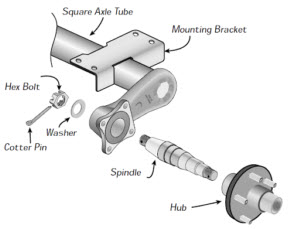The browser you are using is not supported. Please consider using a modern browser.
Trailer Maintenace
Torsion vs Leaf Spring Trailer Axles: Pros, Cons & How to Choose
How to Tell the Difference Between Torsion Axle and Leaf Spring Axle Suspension?
Leaf Spring Axle: If your trailer uses a leaf spring axle, you’ll see stacked metal springs mounted under or over the axle tube with U-bolts. It looks like this:

Torsion Axle: If your trailer uses a torsion axle, you’ll see a solid square axle tube mounted directly to the frame with internal rubber cords (no springs). It looks like this:

What are the pros and cons of leaf spring axles and torsion axles?
Torsion Axles
How They Work:
Torsion axles use thick rubber cords inside the axle housing. As the wheels move, the rubber compresses to provide cushioning. Each wheel acts independently, allowing smoother suspension and shock absorption.
Pros:
-
✅ Smooth Ride: Independent wheel suspension reduces road shock and offers even handling.
-
✅ Low Maintenance: Few moving parts mean less wear and fewer service intervals.
-
✅ Corrosion Resistance: Galvanized tubing and no exposed metal-on-metal action reduce rust risk.
-
✅ Stiffer Frame: Mounted directly to the trailer frame, reducing flex and improving stability.
Cons:
-
❌ Higher Cost: More expensive to buy than leaf springs.
-
❌ Expensive Repairs: Full axle replacement is often required if damaged.
-
❌ No Impact Distribution: A curb or pothole hit affects one wheel only, not shared across the axle.
Leaf Spring Axles
How They Work:
Leaf springs consist of layered steel strips that flex under load. They are the most widely used trailer suspension system due to their simplicity and long track record.
Pros:
-
✅ Proven Reliability: Used for centuries and still standard in most trailer applications.
-
✅ Affordable: Lower upfront cost compared to torsion systems.
-
✅ Easier to Repair: Individual springs or parts can be replaced without full axle replacement.
-
✅ Better Load Distribution: Multi-axle setups share impact across wheels, improving stability.
-
✅ Durable on Uneven Ground: Handles potholes and off-road conditions well.
Cons:
-
❌ Higher Maintenance: Metal-on-metal contact leads to wear, requiring lubrication or part replacement.
-
❌ Harsher Ride: Can feel bouncy, especially with an empty trailer.
-
❌ Corrosion Risk: Exposed steel is more vulnerable to rust, especially in marine environments.
Which Should You Choose?
-
Choose torsion axles if you want smoother towing, lower maintenance, and are willing to invest more upfront.
-
Choose leaf springs if you want a cost-effective, durable system that’s easy to service and better for heavy-duty or multi-axle setups.